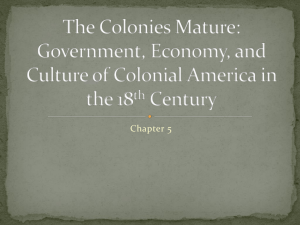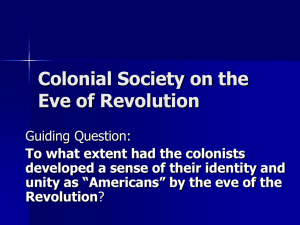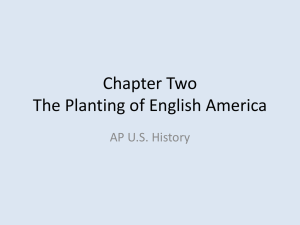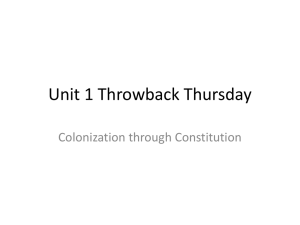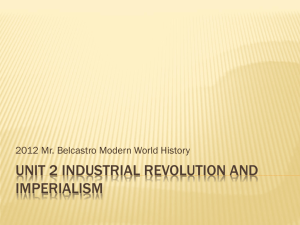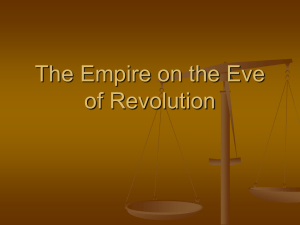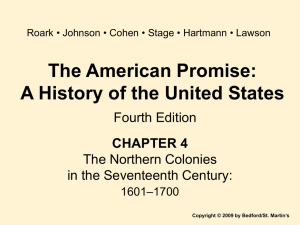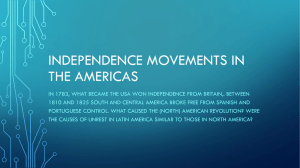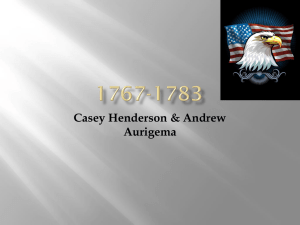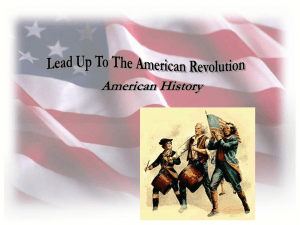Colonial Society on the Eve of Revolution 1700-1775
advertisement
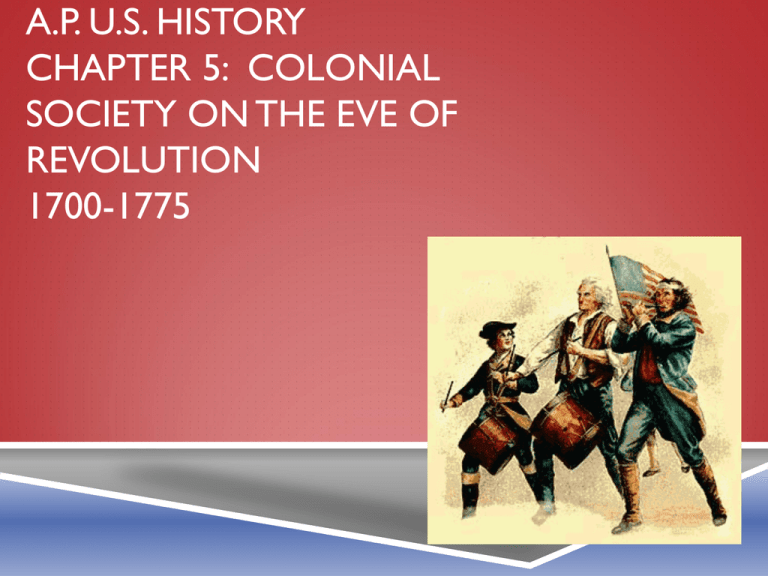
A.P. U.S. HISTORY CHAPTER 5: COLONIAL SOCIETY ON THE EVE OF REVOLUTION 1700-1775 • Britain had 32 colonies in North America in 1775, and only 13 of them opted for Revolution and Independence. • In 1700 the 13 colonies had less than 300,000 people.(but had rapidly growing populations) • In 1775 the 13 colonies had 2.5 million people, of which 500,000 were black. • 400,000 of these were immigrants (both free and forced) but the rest had been born in the colonies through remarkable natural fertility. • The colonies were doubling their numbers every 25 years. • The average American in 1775 was about 16. In 1700 the English outnumbered the colonists 20 to 1, but that margin fell to 3 to 1 by 1775 In 1775 the most populous colonies were VA, MA, PA, N.C., and MD., in that order. 90 percent of Americans were rural in 1775. America had only 4 real cities in that year: Philadelphia (34,000), N.Y.C., Boston, & Charleston. See map on page 85 6% of Americans were Germans in 1775 making up about 1/3rd of Pennsylvania’s population. Germans were primarily Lutherans by faith. Scots-Irish- made up about 7% of the population in 1775. Most were Scottish lowlanders who had been transplanted to Northern Ireland where they were not treated well by the Irish Catholics. Many squatted on Indian and Whiteclaimed land on the frontier, provoking many clashes with Indians and the white owners. Most Scots-Irish hated the British government who had mistreated their people in Scotland and Ireland for decades. About a dozen future American presidents were from this Scots-Irish stock. DIVERSITY IN THE COLONIES Most other non-English immigrants including: Huguenots, Welsh, Dutch, Swedes, Jews, Irish, & Swiss felt no loyalty to the British crown. See percentages on page 86 The population in the 13 colonies was probably the most diverse on Earth at that time. A true “melting pot” of nationalities. New England remained mostly English puritan and was the least diverse region. The middle colonies were the most diverse. Not counting New England, the colonies were about ½ English and non-English in 1775. Of the 56 signers of the Declaration of Independence 18 were non-English and 8 had not been born in the colonies. • Most colonial Americans were • • • • • small farmers. Ministers were the most respected in the communities. No titled nobility existed in America. Colonial America had a high degree of social mobility. Rags to riches stories were fairly common in America and very rare in England. A thriving minority of rich merchants emerged in America in the late 1600s-early 1700s. By the mid 1700’s the number of poor people in the American colonies remained tiny compared with the number in England. By 1750 10% of Bostonians and Philadelphians owned 2/3rds of the wealth. Almost all slaves owned in the south were held by the elite few plantation owners. Most small farmers in the South owned no slaves or were tenant farmers themselves. The English dumped thousands of prisoners on American soil. Slaves, of course, made up the lowest class of Americans. 90% of Americans were involved in agriculture. The middle colonies grew grain, the Chesapeake colonies grew tobacco, and the South grew rice and indigo, New England had small farms and many were engaged in whaling and fishing. On average, life in America was more prosperous than in Europe, or in any nation in the history of the world, up to that time. See map on pg 91. TRIANGULAR TRADE The triangular trade made up only one small part of colonial commerce. New England rum was shipped to Africa where it was sold for Slaves, who were transported to the West Indies in exchange for molasses, which was shipped north to New England to be distilled into rum. Each leg of the triangle made the merchant money. INDUSTRIES IN THE COLONIES • Although manufacturing in the colonies was only secondary to agriculture they did produce, rum, beaver hats, lumber, and iron ore. • Shipbuilding was one of the most important manufacturing segments in the colonies. • One feature of the American economy that strained the relationship between Britain was the growing desire of Americans to trade with other nations (not just England) By 1770 about 400 ships a year were being made in the colonies, and about 1/3 of the British merchant marine were made in America. Britain’s limited population was saturated with American goods by the 1770s. Americans stood to make a lot more money if they could trade with other European nations. PROBLEMS WITH TRANSPORTATION Transportation was very slow in colonial America with very poor dirt trails and roads connecting various points in the colonies. Travelers of all ethnicities, places of origin, occupation, religion, etc frequently jammed into taverns dotting places of travel where the mixing groups talked about all sorts of subjects, especially politics. While a minority of American colonists belonged to an established church, two denominations stood above the others in numbers and power; the Anglican and Congregationalist. The Anglican (Church of England) was the official faith in Georgia, North and South Carolina,Virginia, MD, and part of N.Y. See chart on “estimated religious census, 1775” pg 95. The Anglican faith was less radical and more worldly than that which was established by the Puritans of the early colonial period. The Congregational Church grew out of the Puritan church and was the established faith of all New England states except Rhode Island (which was always fiercely independent). Many American ministers talked about politics and denounced British policies. They were prorevolution Despite the colonial sponsorship of many official religions, America was still very religiously tolerant compared to most places on earth at that time. The Great Awakening- a series of religious revivals that swept through the colonies in the 1730s and 1740s. A reaction to over a century of loosened Puritanism and Calvinism. An attempt to “wake up” Christians in America with zeal. George Whitefield helped start and then spread the movement with fiery sermons in a new evangelical style. Sermons were very emotional and theatrical. (Fire and Brimstone!) Many “Ivy League” colleges like Princeton, Brown, Rutgers, and Dartmouth were founded as “new light” centers of higher learning during the Great Awakening The Great Awakening broke down sectional boundaries as well as denominational lines and helped many colonists feel united that they were “Americans” united by a common history and shared experiences. EDUCATION Traditionally, the English believed that education was for the elite leaders of society not common citizens, and mainly for males. The colonies slowly drifted from this norm and encompassed more and more people into education. The Congregational Church in New England thought that all children should know how to read so that they could read the Bible. EDUCATION IN THE COLONIES Elementary education varied widely in the colonies, but was especially strong in New England, although very present in the middle and southern colonies as well. 9 local colleges were established during the colonial era (see chart on pg 98), primarily to train future ministers. Many colonists sent their sons back to England for college education. CULTURE & THE ARTS • Most artists and writers had to travel to Europe for education and later for most of their work. • Self taught Benjamin Franklin published Poor Richard’s Almanac from 1732 to 1758 which was full of home spun advice emphasizing thrift, industry, morality, and common sense. – Only the Bible was read by more people in the colonies. – Known as the “first Civilized American” THE COLONIAL PRESS By 1776 the colonies had: about 50 public libraries 40 colonial newspapers and many more printing presses. Most papers and essays bent the truth a bit. COLONIAL GOVERNMENT By 1775: 8 of the 13 colonies had royal governors appointed by the king. 3 colonies (MD, PA, and DA) were under proprietors who chose the governor. 2 colonies (CONN, and RI) elected their own governors and had self-governing charters. Almost every colony had a bicameral (2 house) legislature. The upper house was usually appointed by: the crown in the royal colonies the proprietor in the proprietary colonies the voters in the charter colonies The lower house was chosen by the people in the individual colonies (although most colonies required property ownership to vote). Self-taxation through local representation was a rare privilege that Americans cherished above most others. Although many were able, most governors (appointed by the King) were resented by the colonists. Many colonial legislatures withheld the governor’s salary until he came to terms with what they wanted. Local government varied widely among the colonies. COMPARED TO ELSEWHERE ON EARTH… Americans enjoyed a high standard of living They had more political, religious, and economic opportunity They almost certainly ate better too. COLONIAL COMPARISONS Similarities between colonies: • some degree of self-rule • some religious toleration • 3,000 miles away from Great Britain Differences: • Economy • patterns of settlement • Traditions • government • Religion: • Ex. :Puritans in New England did not celebrate Christmas because they thought it was an offensive reminder of “popery.” – “Yuletide is fooltide…”
